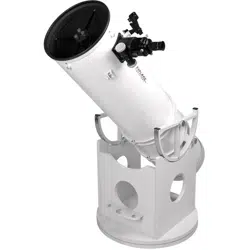Loading ...
Loading ...
Loading ...

15
Hints and Tricks
Calculating magnification
The magnification of a particular telescope configuration is determined by two factors — the focal length of the
telescope and the focal length of the eyepiece. You will find the focal length of almost all eyepieces written on the
eyepiece body.
The magnification is determined by the following formula:
Magnification = Telescope focal length divided by eyepiece focal length
For example, for a 10-inch Dobsonian and a 20mm eyepiece: Magnification = 1270mm/20mm = 63.5x
The eyepiece type, like modified achromatic, Plössl or Super Plössl, does not have any influence on the
magnification, but determines other optical properties like apparent field, chromatic error correction and flatness of
the field of view.
The maximum usable magnification is about two times the diameter of the aperture in millimeters. However, in
nights of bad to average seeing much lower magnifications will produce a more detailed and steadier image. High
magnifications should only be used during periods of extremely steady air on special objects, like double stars.
When you are starting to observe an object, always start with a low magnification. Then center the object in the
field of view and focus with care. Now you can try a higher magnification. When the image is becoming fuzzy or is
moving too fast, go back to the last magnification. Atmosphere – and thus seeing conditions – is always changing.
Please notice that a sharp image at a low magnification will show you more than an over-magnified fuzzy view.
Magnification =
Telescope Focal Length
Eyepiece Focal Length
Loading ...
Loading ...
Loading ...
